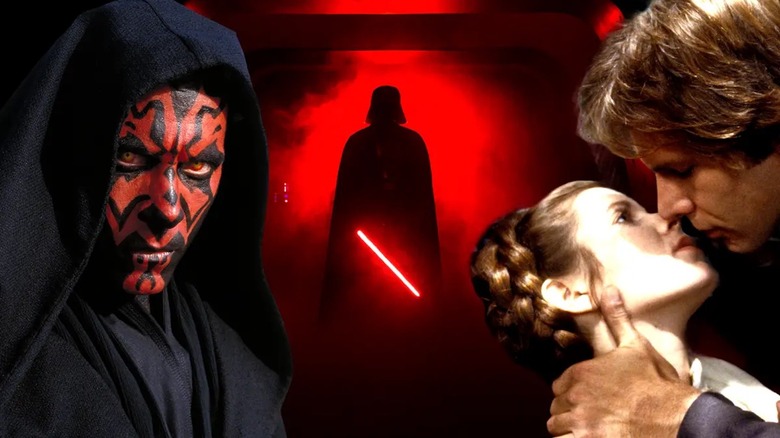
This is the way ... that some of the most famous "Star Wars" moments came to be. Given the multilayered lore behind the galaxy far, far away, it should come as no surprise that many of the plot decisions across the franchise's rich history are more than meets the eye.
George Lucas didn't freeze Han Solo in "The Empire Strikes Back" just for the fun of it. Darth Vader didn't show us the might of his evil in "Rogue One" for nothing. These and other favorite sequences have real-world strategies rooted in their fictional placement. As glorious as "Star Wars" is, it's not exempt from production snafus, casting challenges, and logistical puzzles that require solutions, which occasionally inform a story beat out of necessity.
From movies to TV to theme parks, we thought it'd be fun to highlight a few "Star Wars" plot decisions that were smarter than you think. Some are legend, known the galaxy over. Others you might find surprising. Happy reading, and may the Force be with you, always.
Luke Skywalker's Arc In The Last Jedi And The Rise Of Skywalker
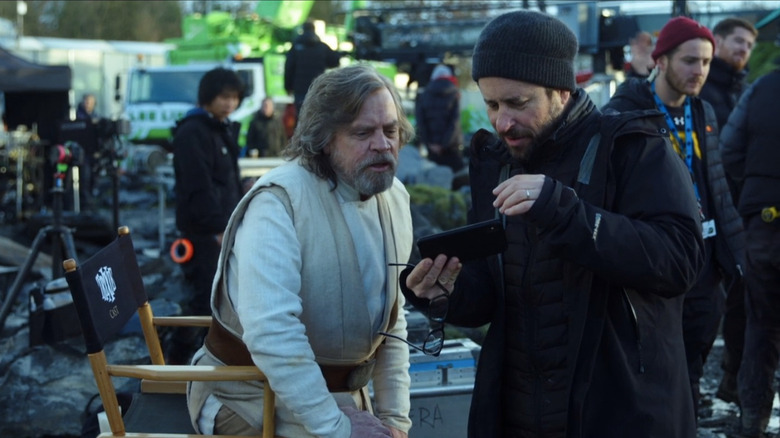
Director J.J. Abrams concludes "The Force Awakens" with Rey extending Luke's lightsaber to him, a wondrous moment as the young scavenger finally locates the near-mythic hero. Rian Johnson's "The Last Jedi" picks up at the same moment, with Luke dismissively tossing the lightsaber aside, uninterested. Actor Mark Hamill wasn't about it. "I told Rian this. It's no surprise," Hamill candidly shares in "The Director and the Jedi," a 2018 documentary. "I said, 'I just fundamentally disagree with your concept of this character and how you use him. Now, having said that, I'll do everything within my power to realize your vision.' It's not my character to decide."
Following Luke's death at the end of "The Last Jedi," his afterlife self returns to encourage Rey in "The Rise of Skywalker," which Abrams again directed. Here, when Rey is the one to dismiss a saber, Luke knowingly teases, "A Jedi weapon deserves more respect." He stops short of winking at the camera. In the 2020 documentary "The Skywalker Legacy," Hamill comments on what he sees as Luke's redemption. "He was a symbol of optimism, and I think that's probably the most satisfying aspect of the character." Daisy Ridley, who plays Rey, adds, "It's probably nice for Mark to be more like the Luke of old, which I think J.J. felt like he really wanted that. It was nice to feel, and even in the scene to feel really comforted that Luke Skywalker is here."
Vader's Final Scene In Rogue One
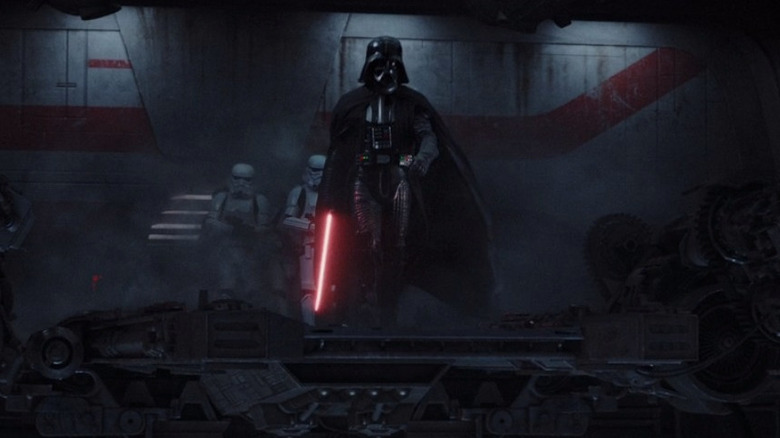
Many fans' favorite part of "Rogue One: A Story Wars Story" is the scene toward the end in which Darth Vader shows his true villainy in epic form. Crazily enough, the sequence was an afterthought. In a 2021 interview with StarWars.com, director Gareth Edwards revealed how it came together. "We always wanted Vader in the movie as much as possible without playing that card too often," Edwards said, with his team being careful to "not abuse that situation."
As production got underway, filmmakers noticed an area of improvement. Firstly, in "A New Hope," the movie "Rogue One" directly leads into, Vader is already livid with anger. The footage Edwards planned for "Rogue One" didn't quite get Vader to that place yet; it could use one more bridge. According to Edwards, Jabez Olssen, one of the editors, came up with the idea of giving Vader what Edwards called "this T. Rex 'Jurassic Park' moment of the main bad guy coming back at the very end."
Once Lucasfilm president Kathleen Kennedy approved, it was off to the races as Edwards and company pulled off a "last-minute scramble" to film the scene. "I just thought it was a nice little cherry on top," Edwards said. "I really didn't think it would be what everyone talked about when they talk about the movie."
Han And Leia's Declaration Of Love In The Empire Strikes Back
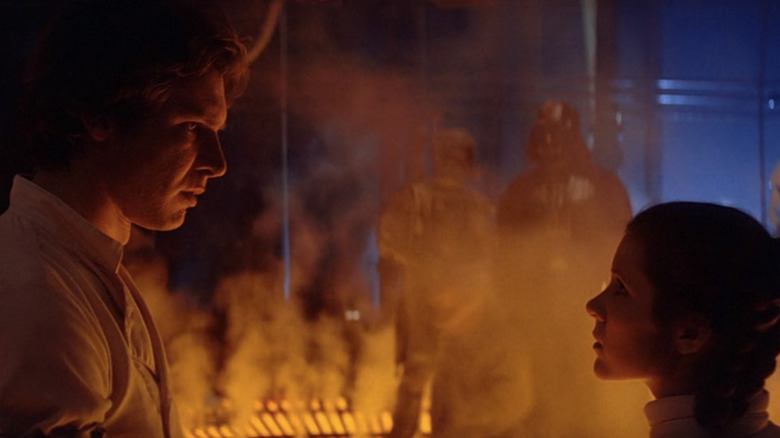
It was the line that launched a thousand couples' t-shirts. Just before Han Solo drops into the carbonite freezing chamber during "The Empire Strikes Back," Leia longingly calls out, "I love you." Equally as passionate, but totally true to his character, Han replies, "I know." The iconic exchange wasn't in the original script.
Initially, Han was supposed to reply, "I love you too." While enigmatic of the classic Hollywood romance that these characters had earned, the line just didn't feel right. "It seemed to me that we weren't taking advantage of the character we had established for Han Solo," actor Harrison Ford reflects in the 2004 documentary "Empire of Dreams: The Story of the Star Wars Trilogy." Director Irvin Kershner affirms the trial-and-error. "We tried take after take after take. Nothing satisfied me," Kershner says. "Finally, I said, 'Harrison, don't think about it. Don't think about it. Let's do it. Okay, action!"
"I love you!" Carrie Fisher shouted as Leia. Ford then improvised the now-famous line, "I know." Kershner was pleased. "That's a great line. That's Han Solo."
The Setting Of Galaxy's Edge
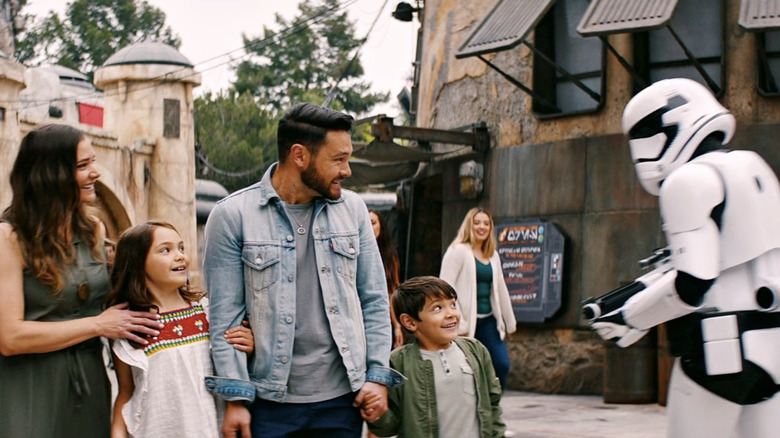
Disney Imagineers faced a challenge when they decided to build an entire area based on "Star Wars" at Disneyland and Walt Disney World. The franchise was no stranger to the Disney theme parks -- the "Star Tours" ride opened in the '80s -- but a walkable, explorable expansion was a much taller order and inflicted much more pressure than a singular attraction. Of the many recognizable planets and environments from the "Star Wars" films that park guests might want to visit, which location should the Imagineers build that would live up to expectations? The answer: none of them.
When "Star Wars: Galaxy's Edge" opened in 2019, it welcomed travelers to a new planet, Batuu. Author Leslie Iwerks writes about its creation in "The Imagineering Story: The Official Biography of Walt Disney Imagineering," saying the designers "knew they had to create an environment that didn't already belong to someone else's story." Imagineer Scott Trowbridge tells Iwerks, "We wanted to build a place where we could discover our own story -- a new story for us."
As attendees wander "Galaxy's Edge," they still encounter familiar faces. Both of the land's anchor attractions prominently feature "Star Wars" characters from the sequel trilogy, with the original actors reprising their roles. The difference is that the guest is the hero. In bringing vacationers to Batuu, Disney makes it easier for them to be a participant in the action of a new story, rather than an observer of a narrative they already know.
Darth Maul
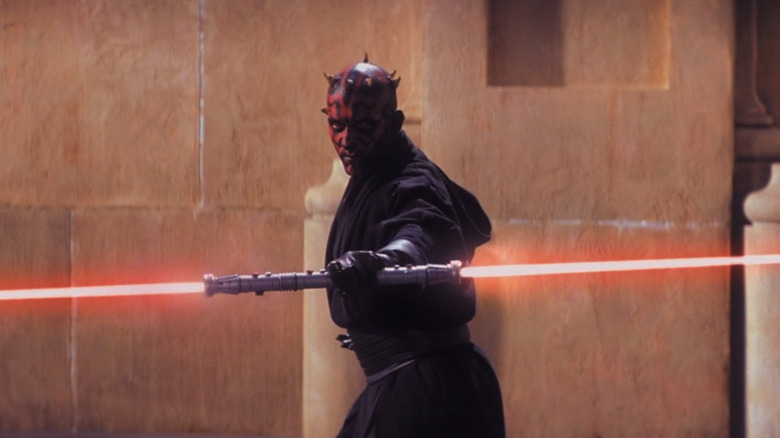
How do you top Darth Vader? George Lucas considered this challenging question when developing "The Phantom Menace," the first entry in his prequel trilogy and the first new "Star Wars" movie since the originals concluded in 1983. Even if they didn't mean to, audiences were going to compare any newly introduced villain to Vader. Lucas had to deliver.
The filmmaker was hyper-aware of this expectation, as he shared in a 1999 interview with Empire. Lucas said it was "sort of a tradition" for audiences to like the antagonist more than the heroes. "Obviously I was trying to make a villain who was sufficient to replace Darth Vader because Vader was such a great villain. I needed something to stop people [from] saying, 'Ah, what a wimpy villain next to Darth Vader.'"
The solution? Enter Darth Maul, a terrifying bad guy with spikes on his head and a double-bladed lightsaber. Yep, that'll do it. More than looks, though, Darth Maul's character served a purpose within the prequels' mythology. Lucas continued, "I wanted something that revealed a little more understanding of what an apprentice is, because this is obviously where this is all going," hinting toward Anakin's transformation into Darth Vader, which audiences knew at the time was coming, but hadn't seen yet.
The Last Jedi's Crystal Deer
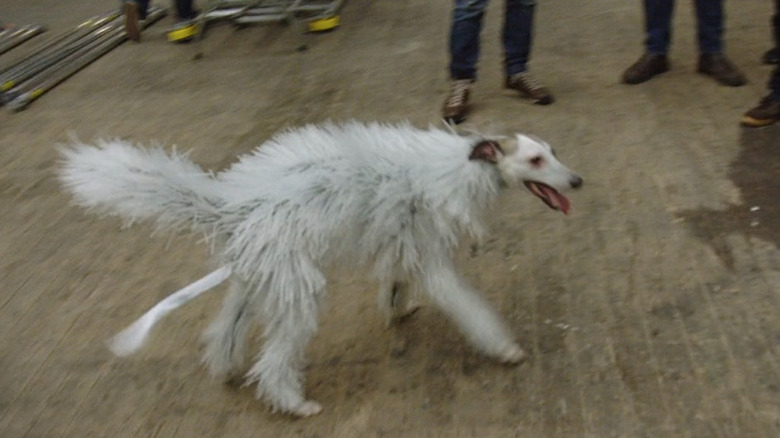
The animals known as vulptices, which Finn describes as "crystal critters," appear as computer-generated imagery in "The Last Jedi." During pre-production, though, director Rian Johnson apparently evaluated how real dogs would look and behave in the role. Footage in the documentary "The Director and the Jedi" shows Johnson stopping by a workshop to observe a dog wearing a garment covered in objects emulating the critters' signature crystals. As the dog performs a walk with a trainer, Johnson murmurs in disapproval. His face says it all: It's not going to work this way.
The choice to instead animate the creatures likely allowed for more flexibility with their role in the narrative. When Finn, Poe, Leia, and the others from the Resistance encounter the vulptices inside a cave on the planet Crait, they follow the animals to safety and avoid the First Order's wrath. The agility and physicality might have been too demanding to expect a real dog to perform while also appearing to be an alien creature.
Cara Dune's Recruitment
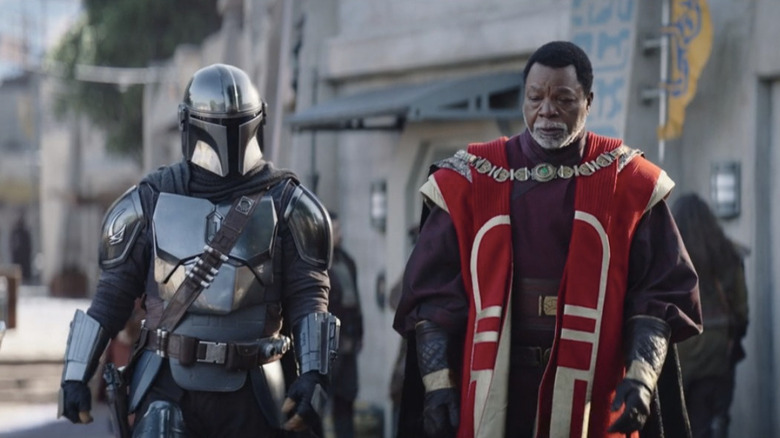
Following problematic remarks from Gina Carano, who played Cara Dune in the first two seasons of "The Mandalorian," Lucasfilm didn't invite the actress back for Season 3. In a 2021 statement shortly after Carano's comments, a Lucasfilm spokesperson said, "Gina Carano is not currently employed by Lucasfilm and there are no plans for her to be in the future. Nevertheless, her social media posts denigrating people based on their cultural and religious identities are abhorrent and unacceptable."
Rather than recast Cara Dune, the team behind "The Mandalorian" simply wrote her out of the story. The last time audiences saw her in the Season 2 finale, she had just helped Din Djarin (Pedro Pascal) rescue Grogu from villain Moff Gideon (Giancarlo Esposito). In the Season 3 premiere, when Greef Karga (Carl Weathers) asks Din to become a marshal, Din counters, "What about Marshal Dune?" Greef replies, "After she brought in Moff Gideon, she was recruited by special forces."
George Lucas Splitting Up His Initial Star Wars Draft Into Multiple Parts
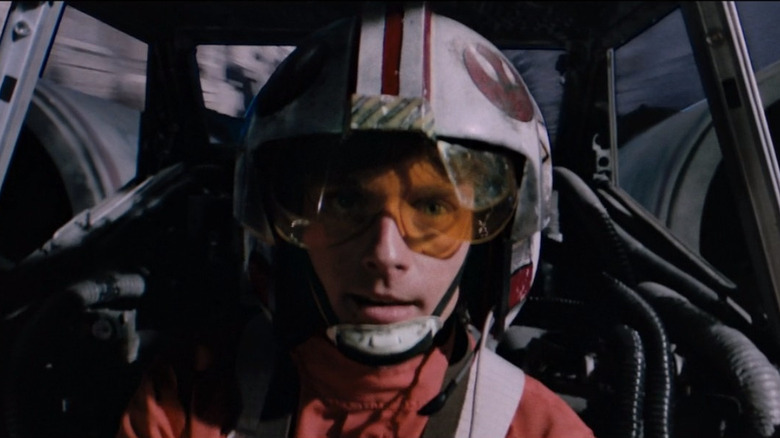
At first, Luke Skywalker's story began and ended in one, singular script. The entirety of the original "Star Wars," later retitled "A New Hope," was just the first third of George Lucas' preliminary script that he decided to split into three movies. "It got to be a very fat script. About 200 pages," Lucas shares in "Empire of Dreams." "The story had gotten away from me, so the only way I could cope with it was to say, 'I'll take the first third. I'll take the first act and I'll make that into a movie.' But I'd written all this stuff ... so I put it on the shelf and I said, 'By hook or by crook, I will finish this movie.'"
In the sequels, Lucas is only credited as a co-writer on "Return of the Jedi," not "The Empire Strikes Back." However, he receives a story credit on both films, implying his main ideas from that original script might have remained. Regardless of how faithful the two follow-ups were to the second and third acts of Lucas' initial script, its length directly informed where the story of "A New Hope" ended.
Leia's Role In The Rise Of Skywalker

Carrie Fisher passed away in December 2016, after production had wrapped on "The Last Jedi," but before it had begun for "The Rise of Skywalker." Leia was meant to be the lead among the legacy actors in the final chapter of the sequel trilogy. Recasting the character was out of the question. Fisher's death led to the team reducing Leia's role and piecing together her scenes from deleted footage they initially filmed for "The Force Awakens." They wrote new script material around the unused scenes to ensure Fisher remained part of the story. Several cast and crew members elaborate on the process in the documentary "The Skywalker Legacy."
"The Rise of Skywalker" director J.J. Abrams comments, "When we were doing 'VII,' [Fisher] knew that movie was very much Han's story and then 'VIII' was very much Luke's. The thing she had said was that 'IX' should be Leia's, and that's really something that we've tried to do."
Billie Lourd, Fisher's daughter, co-stars alongside Leia in the sequel trilogy as Kaydel Ko Connix, a lieutenant in the Resistance. "It's literally like a gift from her," Lourd says of Fisher's scenes in the final film. Then adds with a laugh, "Or her forcing us to make her the star of the movie. Probably both." She continues, "I'm so happy, and she would be happy that it's her movie, too."
Ahsoka's Live-Action Debut
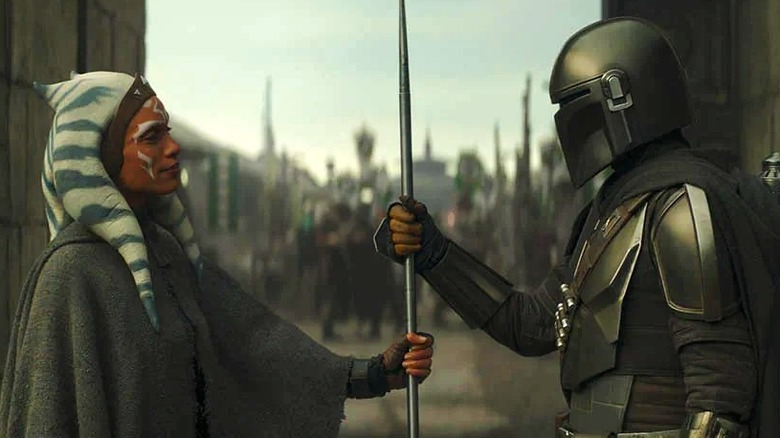
Jon Favreau, creator of "The Mandalorian," is no stranger to narrative world-building. As director of the first two "Iron Man" movies and an executive producer of "Avengers: Infinity War" and "Avengers: Endgame," he has experience creating interconnected stories and characters across different projects. Therefore, when Ahsoka -- a Jedi first introduced in the animated "Star Wars: The Clone Wars" movie and series in 2008 -- made her live-action debut during "The Mandalorian" Season 2 in November 2020, her appearance was anything but a one-off.
Just a few weeks after the character's surprise arrival in the Mandoverse, Disney announced "Ahsoka," a live-action series for Disney+. Favreau developed the show with Dave Filoni, his frequent "Star Wars" collaborator, who first created Ahsoka all those years ago. Rosario Dawson, who played Ahsoka on "The Mandalorian" and reprised her in "The Book of Boba Fett," once again brings the fan-favorite Jedi to life.
It's a leap to say Favreau and the team already had everything mapped out for their slate of live-action "Star Wars" television projects when Dawson initially filmed her episode of "The Mandalorian." Still, knowing Favreau's history and the ambition Lucasfilm clearly already had for its streaming intentions, doing more with the character had to have been on his mind. Ahsoka crossing paths with Din and Grogu served as a backdoor pilot of sorts for an adventure of her own, helping both the crew and the audience get a grasp of her character.
George Lucas' Instructions To Alden Ehrenreich
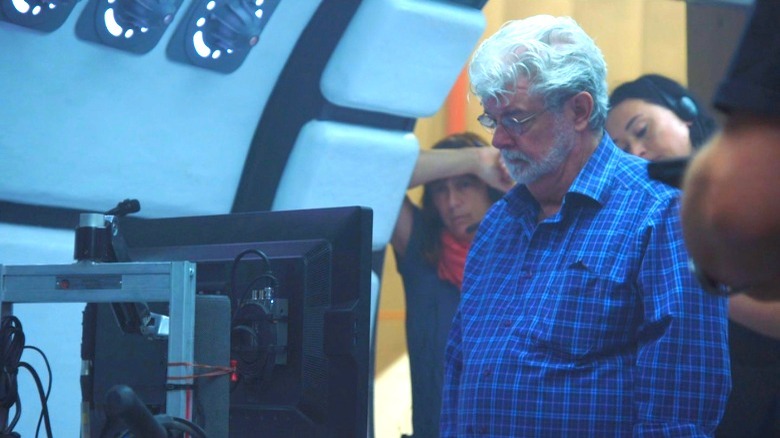
Imagine being actor Alden Ehrenreich, cast as Han Solo in 2018's "Solo: A Star Wars Story." Surely, he felt the weight of what the character means to millions of people and recognized the huge shoes he had to fill following Harrison Ford originating the role. The one thing that might make the pressure even higher? A personal visit to the set from George Lucas.
Director Ron Howard recalls Lucas' visit in a roundtable interview in the film's Blu-ray and Disney+ extras. On the day Lucas swung by, Ehrenreich filmed a scene in which Han places a clothes hanger onto a rack while talking to Qi'ra (Emilia Clarke). Howard says Lucas "didn't want to interfere at all, but he's a filmmaker. At a certain point, he leaned over and said, 'When [Han] walks over, he wouldn't hang up that cloak. He wouldn't do that.'" Lucas instead suggested, "He'd throw it away. He'd throw it over his shoulder. He doesn't give a damn."
That was Howard's first day on the project, following a switch-up in the movie's leadership. Production had a long way to go before completion. Lucas correcting Han's demeanor in a seemingly small way likely helped inform Ehrenreich's portrayal of him thereafter, especially as Howard stepped in to steer the ship with a fresh vision.
Han Solo's Carbonite Freeze
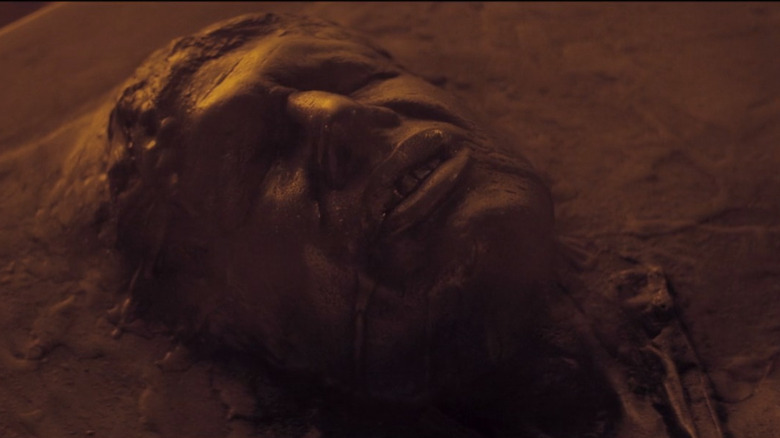
It's hard to imagine "Return of the Jedi," the final film in the original "Star Wars" trilogy, without Harrison Ford. Sure, "The Empire Strikes Back" leaves the question of Han Solo's life in the balance, but George Lucas wouldn't kill off such an iconic adventurer, right? Besides, Ford wouldn't want to miss being part of the grand conclusion of a three-part, history-making saga, right? Right?!
Han Solo helping save the galaxy in "Return of the Jedi" wasn't guaranteed. Ford "wasn't committed to doing it a third time," Mark Hamill revealed in an interview during the press tour for "The Empire Strikes Back." Freezing Han in carbonite provided Lucas and Ford with a win-win narrative solution. If Ford returned, Han could unfreeze. If Ford bowed out, Han's story would be finished and had already been addressed to the audience. This smartly avoided the possibility of leaving Han carefree at the end of "The Empire Strikes Back," only to require some roundabout explanation for an absence in "Return of the Jedi" if Ford didn't come back. The carbonite freeze solved a casting uncertainty and doubled as a tantalizing plot point that only heightened the audience's anticipation to find out what happened next.
Read this next: Star Wars Deleted Scenes That Could've Changed Everything
The post 12 Star Wars Plot Decisions That Were Smarter Than You Think appeared first on /Film.

